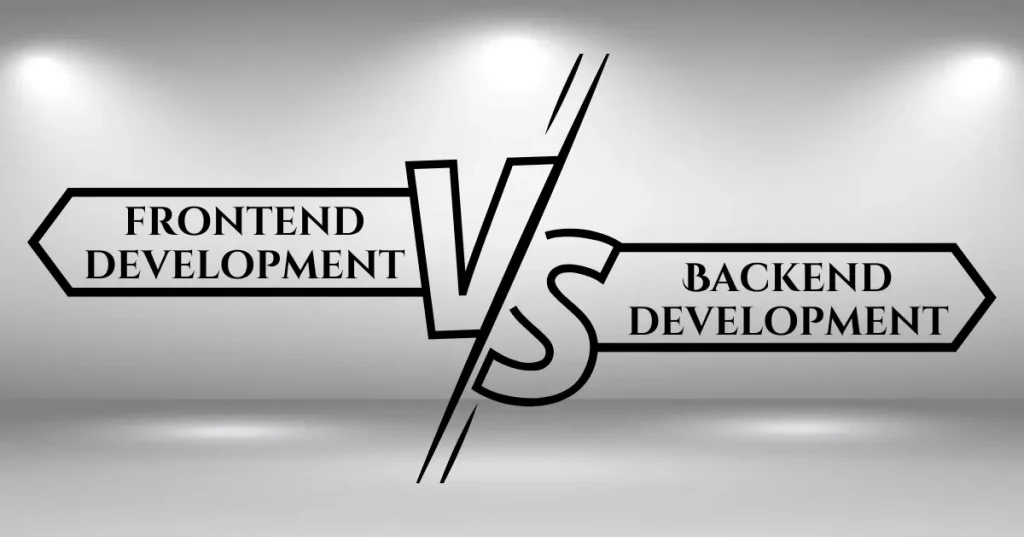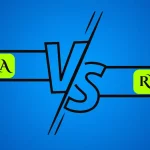When we talk about frontend and backend development, we are really talking about two different ways developers build websites and applications for users. The front-end is all about what people see — the visual side. It covers the design, layout, colors, fonts, and every little part that makes it easy for users to interact with buttons, text, graphics, and messages. These aspects are the key to making a site look modern and engaging, while also working properly. On the other side, the back-end is like the invisible structure that keeps everything running smoothly. It is responsible for storing data, processing requests, and managing tasks behind the scenes.
In my experience, I’ve seen that both areas demand very different technical strengths. A front-end role requires creativity in design and attention to elements like checkboxes and components. In contrast, a back-end role involves a deep understanding of infrastructure, processes, code, and software. Interestingly, many full-stack developers combine both worlds, using coding and programming languages, tools, and skills to create complete applications. Within the computer technology industry, these two sides are often compared to a restaurant: the customer faces the host in the front, while the real work happens at the back. This shows the similarities, differences, and critical balance needed to make the internet a part of modern life — helping us communicate, shop, play, and learn through digital experiences.
Explore More: Homeschooling and Traditional Schooling
What’s the Difference Between Front-End vs Back-End?
The front-end is often described as the part of a website or application that users can see and interact with. It includes the visual side, such as design, layout, colors, fonts, and interactive elements. When I worked on my first project, I realized how important these aspects are because even small buttons, graphics, or messages can change how a person feels while browsing. A strong skillset in creative thinking, coding, and communication is essential for front-end developers. They use programming languages to create pages that not only look appealing but also function properly for the customer.
On the other hand, the back-end works like the structure and infrastructure hidden behind the scenes. It deals with servers, databases, data, logic, and processes that keep the system running. A back-end developer focuses on server-side code, software, and technologies that make everything work smoothly. I like to compare it to a restaurant: the host greets you at the front while the heavy machinery, system, and tasks in the kitchen ensure the food comes out right. This side requires strong technical expertise, an understanding of programming languages, tools, and even knowledge of industry standards. No matter if you are working in web development, software careers, or aiming to become a full-stack professional, both areas are critical and must be designed cohesively to deliver the best digital experiences.
Front-End and Back-End Development – A Complete Table Comparison
| Category | Front-End | Back-End |
|---|---|---|
| Focus | front-end, designing, physical appearance, visual aspect, fonts, colors, layout, graphics, UI, interface, site designs | back-end, structure, logic, server-side, code, system, architecture, database architecture, services, libraries |
| Programming Languages | JavaScript, HTML, CSS | Python, Java, Ruby, PHP, C#, Node.js |
| Frameworks & Libraries | jQuery, AngularJS, SASS, Bootstrap, EmberJS, React, Vue.js, Angular | Django, Laravel, Spring, Zend, Symfony, CakePHP, Rails |
| Databases | Works indirectly with databases for display | Directly manages MySQL, MongoDB, PostgreSQL |
| Tools & Platforms | text editors, browser DevTools, Photoshop, Figma | IDEs, Postman, GUIs |
| Collaboration | designers, UX/UI, clients, management, business stakeholders | administrators, management, business stakeholders, front-end developers |
| Core Tasks | create interactive, responsive, user experience, client-side interaction | data-driven applications, APIs, caching, concurrency, requests, files, CDN |
| Security | input validation, authentication, basic security workflows | comprehensive security, protect databases, encryption, secure practices |
| Performance | Ensures responsive, interactive, visually appealing web experience | Ensures reliable, functional, optimized performance, handles thousands of requests |
| Average Salary | $80,796 | $90,652 |
| Careers | front-end developer, UI developer | back-end developer, database engineer |
Front-End Development
Front-End Development is about creating the side of a website that users directly see and use. A Front-End Developer makes sure the layout, style, and structure of a site are user-friendly, responsive, and visually appealing. Using HTML, CSS, and JavaScript, they build pages that work smoothly across browsers and devices. These roles demand a mix of technical skill and creativity to keep the site attractive and functional. Frameworks like Bootstrap and AngularJS, along with libraries such as jQuery, help in speeding up the process and maintaining consistency.
Frontend Technologies
To build smooth user interfaces (UI) and engaging user experiences (UX), frontend developers rely on a set of modern technologies. These tools make websites attractive, responsive, and interactive. Some key frontend technologies are:
- HTML (HyperText Markup Language): Defines the basic structure of a webpage, including elements like headings, text, links, and images.
- CSS (Cascading Style Sheets): Handles the design part of a site by controlling fonts, colors, layouts, and responsiveness across devices.
- JavaScript: Adds interactivity to the web. It powers dynamic elements such as forms, animations, buttons, and interactive maps.
- Frontend Frameworks: Popular options include React, Angular, Vue.js, Tailwind, and Bootstrap, which help developers create scalable and fast web applications.
- Frontend Libraries: Tools like jQuery and SASS are widely used to simplify coding and speed up the development process.
Also Learn: Thesis vs Dissertation
Back-End Development
When we talk about Back-End Development, we are focusing on the server side of a website, where the real logic and functionality live. A Back-end Developer builds and maintains the databases, applications, and APIs that keep everything running behind the scenes. From my own work, this role demands strong problem-solving skills, the ability to debug complex systems, and clear communication skills to collaborate with front-end teams and business stakeholders. Using programming languages like Python, Java, and Ruby, developers create the structure that allows a site’s visible interface to exist. They often rely on SQL, Oracle, and other tools to store and manage data, while also applying their technical skills in version control, software testing, and handling business logic.
Backend Technologies
To make websites run smoothly, Backend Development depends on different technologies that manage the server-side logic and the flow of data. These tools ensure applications remain fast, reliable, and secure. Some widely used backend technologies are:
- Programming Languages: Popular options include Python, Ruby, Java, PHP, Node.js, and C#, which power the creation of applications and services.
- Databases: Backend systems connect with MySQL, PostgreSQL, MongoDB, and SQLite to organize, store, and update data effectively.
- Web Servers: Technologies like Apache, Nginx, and IIS process HTTP requests and deliver website content to users.
- Backend Frameworks: Tools such as Django, Ruby on Rails, Express.js, and Spring Boot help developers build applications more efficiently with ready-to-use structures.
- Backend Libraries: Packages like Mongoose, Socket.io, JDBC, and Pandas simplify coding tasks and speed up backend development.
Read More: Online and Offline Education
Front-end and Back-end Developer Salary
Frontend Developer
The salary of a frontend developer can vary depending on experience, location, and the company they work for. On average, such professionals earn between $80,000 and $100,000 annually. An entry-level developer may start with a lower package, while an experienced one, especially when working in high-demand areas, can secure higher amounts. Reports from March 2025 show that a frontend developer in the US earns around $87,412 per year on an annual basis.
Backend developer
On the other hand, a backend developer usually earns more because of the complexity, technical nature, and depth of the work in managing databases, server logic, and application architecture. Their salaries typically range between $90,000 and $120,000 per year. A backend developer in the US has an annual income close to $87,325. These variations occur due to specific technologies they specialize in, as well as the demand for those skills across industries.
The Difference Between Learning vs Education
Frequently Asked Questions
What is frontend and backend development?
Front-end development focuses on the visual aspects of a website that users see and interact with, while the Back-end comprises the site’s structure, system, data, and logic. Together, they combine to create interactive, visually pleasing websites.
Can I learn frontend in 1 month?
Absolutely, you can learn front-end development in one month with dedication, the right resources, and a clear plan to build a solid foundation and become a proficient front-end developer in this timeframe.
What is needed for front-end development?
Front-end development needs programming languages like HTML, CSS, and JavaScript, plus frameworks and libraries such as jQuery, AngularJS, SASS, Bootstrap, and EmberJS, while the best developers show creativity, good communication, and strong technical skills.
Is frontend difficult?
Front-end web development is an accessible programming field where people become efficient in six months, but the difficult part of learning is overcoming Imposter Syndrome and challenges associated with it.
Conclusion
Both Frontend and Backend development are two sides of the same coin, each playing a crucial role in the web world. Frontend developers focus on the interface that users interact with, while backend developers manage the underlying data, logic, and functionality to ensure everything works properly. From my experience, understanding both is essential if you want to pursue a career in technology, whether you focus on one area or aim to become a full-stack expert. By mastering tools and technologies, developers can build robust, scalable applications that truly stand out.


